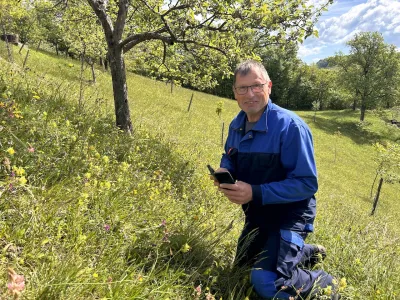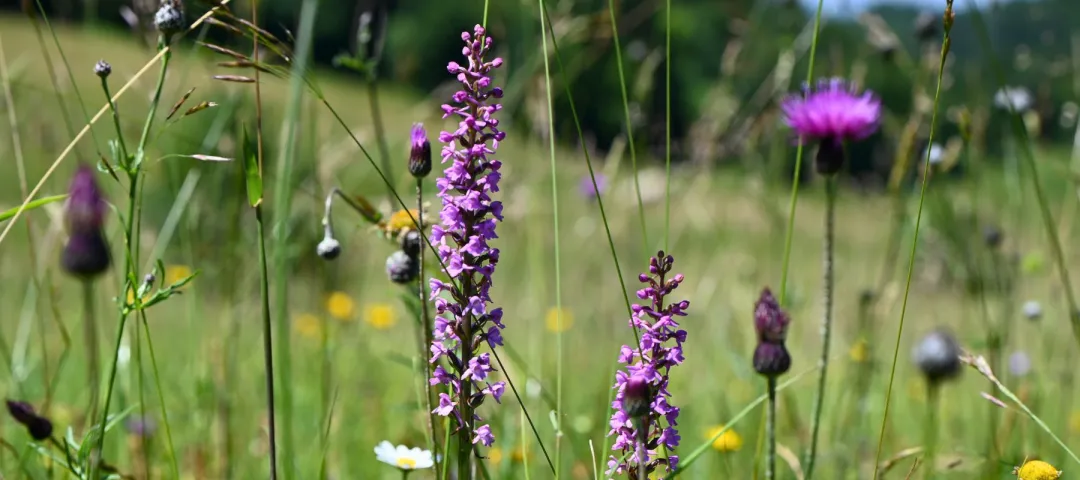General information
RDP Priority
- P4. Ecosystems management
RDP Focus Area
- 4A: Biodiversity restoration, preservation & enhancement
RDP Measure
- M16: Cooperation
Beneficiary type
- Operational group
Summary
Farmland flora conservation maintains ecosystem services for EU agricultural productivity and environmental health. Results-based biodiversity payments for EU farmers present a useful alternative to action-based payments because funding is linked to measurable ecological outcomes, leaving farmers free to farm without action-based conditions.
This EIP Operational Group project developed a result-oriented CAP funding measure for conserving habitat: Semi-natural dry grassland and shrub phase on carbonate soils (Festuco-Brometalia). It was a pioneering project for Slovenia and motivated farmers to participate in monitoring habitat quality, using tools such as species identification sheets.
Peer-learning and knowledge networking built results-oriented capacity within the farming communities. Farmers can now identify species and make habitat inventories. Other project work analysed soil, nutrients, and grazing habits. A digital monitoring tool (My Meadow) provides a useful project legacy which simplifies farmer roles in the results-oriented biodiversity payments scheme. It is expected to become operational in the CAP Strategic Plan during 2025.
Results
- This project prepared a result-oriented CAP measure for the habitat HT 6210(*).
- Interest in the measure was registered by 73 farms, including from outside the project area. These farms will be able to use the methodology in 2025.
- Higher financial compensation for farmers compared to the previous situation motivates nature-friendly farm management.
- 1 mobile application for monitoring the state of preservation of the habitat type, which enables annual monitoring of the meadow for CAP reporting.
- 164 inventories and the mobile application recorded 1637 indicator species.
- 35 members of the project partnership participated in 3 Austrian training courses.
- Exchange of peer learning experience with farms from abroad, leading to production of a ‘Farmer Teaches Farmer’ manual and 8 ‘Farmer teaches farmer’ workshops, attracting more than 50 farmers.
- Annual monitoring of cuckoo populations as a fauna indicator species.
- 1 protocol to evaluate extensively cultivated Lowland meadows.
- 2 ‘farminar’ films produced and promoted.

Promoter
Institute of the Republic of Slovenia for Nature Conservation*
* The Project promoter/beneficiary is an EIP-AGRI Operational Group ©
Funding
Total budget 248 662 (EUR)
RDP support: 217 511 (EUR)
Private/own: 31 151 (EUR)
Themen
Ressourcen
Documents
Context
Farmland flora conservation within the EU is crucial for maintaining biodiversity, which underpins ecosystem services essential for agricultural productivity and environmental health. Biodiverse farmland supports pollinators, enhances soil fertility, and provides resilience against pests and diseases. The conservation of native plant species also contributes to cultural heritage and traditional farming practices, ultimately fostering sustainable agricultural systems.
Despite the benefits of EU funds aimed at conserving farmland biodiversity, some farmers can be hesitant to engage with these initiatives. Concerns can stem from perceived complexities, alongside worries that compliance with conservation measures may limit their operational flexibility. Additionally, a lack of immediate economic incentives can discourage participation, if farmers prioritise short-term productivity over long-term ecological gains.
Results-based biodiversity payments (RBPs) present a compelling alternative to action-based payments (ABPs) for EU farmers, primarily by aligning financial incentives with measurable ecological outcomes. Unlike ABPs, which compensate farmers for implementing specific practices regardless of their effectiveness, RBPs reward them based on the actual biodiversity improvements achieved on their land. This intrinsic focus on results fosters accountability and encourages innovative conservation strategies tailored to local ecosystems and farmers’ economic needs.
RBPs can enhance farmer engagement and stewardship by empowering them to take ownership of biodiversity goals. As farmers are incentivised to monitor and adapt their practices in response to ecological feedback, they become active participants in conservation efforts rather than passive recipients of funding. This dynamic not only promotes sustainable agricultural practices but also cultivates a deeper understanding of environmental stewardship within farming communities.
Objectives
The main goals of this EIP Operational Group project were:
- Greater uptake of CAP-funded nature conservation measures.
- Developing an RBP methodology for managing dry and semi-dry grassland habitats.
- Motivating farmers through training to recognise how different practices affect meadows.
- Preservation of variegated grasslands and prevention of biodiversity loss.
- Conserving farming in areas with limited opportunities for agricultural activity, especially preventing the risk of abandonment or intensification.
- Evaluating monetary compensation for the management of variegated grasslands
The main target group of the project were farmers who manage species-rich dry grasslands in the area of Haloz, Kuma and Gorjanci.
Activities
2022
- Inventory census of habitat types on partner farms confirming baseline condition of grasslands and selected meadows with habitat types 6210(*) and 6510.
- Agreeing indicator plants for both habitat types and preparing related field forms.Meeting with the Agency for Agricultural Markets and Rural Development (payment agency - ARSKTRP) regarding the implementation of a result-oriented measure for the preservation of dry grasslands.
- Austrian study trip to learn about problems caused by abandoning agriculture.
- Project awareness raising and visibility actions.
2023
- Refining the initial version of the field survey census form.
- Collection of soil and manure samples for analysis.
- Preparation and printing of brochures of indicator plants for farmers to ease identification of indicator plants in the meadow.
- Training in the project methodology for agricultural advisers and farmers.
- Field workshops showing indicator plants.
- Workshop with the Ministry of Agriculture, Forestry and Food (MKGP) and ARSKTRP
- Development and testing of the mobile application ‘My Meadow’.
- Carrying out meadow inventories with the mobile application.
- Austrian study tour at a ‘Farmer teaches farmer’ workshop.
- Grazing monitoring with GPS collars and data analysis.
- Project awareness raising and visibility actions.
2024
- Feasibility analysis of the methodology and its coordination by comparing grassland assessments between different stakeholders.
- Meeting of MKGP and ARSKTRP.
- Reprint of brochures.
- Training for agricultural advisors.
- Austrian study tour at a ‘Farmer teaches farmer’ workshop.
- Preparation of manuals for farms.
- Field workshops for local farms using the ‘Farmer teaches farmer’ method.
- Carrying out meadow inventories with the application ‘My Meadow’
- Presentation of the project and action to the Danish students of the Forestry and Landscape College at the University of Copenhagen
- Producing two ‘Farminar’ films.
- Austrian study tour at a ‘Farmer teaches farmer’ workshop.
- Preparing a protocol to evaluate Lowland extensively cultivated meadow habitat type that are also threatened by intensification.
Main results
- This project created a result-oriented CAP measure for the habitat HT 6210(*).
- Interest in the measure was registered by 73 farms, including from outside the project area. These farms will be able to use the methodology in 2025.
- Higher financial compensation for farmers compared to the previous situation motivates nature-friendly farm management.
- Better knowledge of the conservation status of habitat type 6210(*) in Natura 2000 areas and one protocol for monitoring the condition of this habitat.
- One mobile application for monitoring the state of preservation of the habitat type, which enables annual monitoring of the meadow for CAP reporting.
- 164 censuses with the mobile application and recorded 1637 indicator plants.
- 60 farmers attended four demonstration workshops.
- 2 workshops for agricultural consultants.
- A ‘Farmer Teaches Farmer’ manual was prepared to provide better knowledge about farmland biodiversity.
- 8 ‘Farmer teaches farmer’ workshops held in the local area, attracting more than 50 farmers with biodiversity on their farm.
- Annual monitoring of cuckoo populations as a fauna indicator species.
- 1 protocol to evaluate Lowland extensively cultivated meadows.
- 35 members of the project partnership participated in 3 Austrian training courses.
- 2 ‘farminars’ recorded promoting the new results measure and the importance of variegated grasslands.
- ‘My Meadow’ mobile application was developed, helping farmers carry out meadow inventories themselves.
- Exchange of peer-learning experience with farms from abroad, transferring new practices such as the ‘Farmer teaches farmer’ method, which trains farms in the local area to spread information about the measure.
Key lessons
The ‘My Meadow’ mobile application is easy to use and is the first application of its kind that farmers can use to monitor the state of the meadow themselves.
Digitalisation of the wildlife censuses enables rapid and remote insight into the census data, which is essential during the census period, as plants quickly bloom in farm fields. Digitalisation also facilitates communication between farmers and different professions, as expert advisors can remotely check the census. This helps overcome physical distances and improves access to professional services.
Farms were willing to cooperate. They trusted the project and dedicated a lot of their time during the busiest times of their farming year.
Farmers are now trained to spread knowledge themselves and teach other farms about the importance of biodiversity on their farm and how to make an inventory with the app.
"Together with the project collaborators, we also found rare flowers on our farm that we had not even noticed before. I hope that with such management, we will leave a rich dowry to our descendants."
Nika Debeljak

